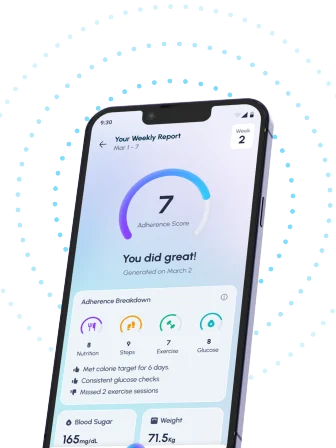Being diagnosed with type 2 diabetes can feel overwhelming, but the good news is: Yes, you can live a normal, healthy, and fulfilling life with diabetes!
Diabetes does not mean you have to give up your favorite foods, hobbies, or an active lifestyle—it just requires some adjustments to manage your blood sugar effectively.
👉 What changes do you need to make?
👉 Can you still eat your favorite foods?
👉 How does diabetes impact life expectancy?
In this comprehensive guide, we’ll discuss how to manage type 2 diabetes, improve your quality of life, and stay healthy for the long term.
What Does It Mean to Live a “Normal Life” with Type 2 Diabetes?
A normal life with diabetes means you can:
✔ Enjoy a balanced diet (without extreme restrictions)
✔ Stay active and fit (without exhausting yourself)
✔ Keep blood sugar levels in check
✔ Prevent diabetes complications
📌 Key Takeaway: Type 2 diabetes is manageable with the right lifestyle adjustments, and you can live just as long and healthily as anyone else.
How to Live a Healthy and Normal Life with Type 2 Diabetes
1. Managing Blood Sugar Levels Effectively
Keeping blood sugar within a healthy range is the key to avoiding complications and staying active.
📌 Target Blood Sugar Levels for Diabetics (Source: CDC)
| Time of Day | Ideal Blood Sugar Range |
|---|---|
| Fasting (before eating) | 80-130 mg/dL |
| After meals (1-2 hours post-meal) | Below 180 mg/dL |
✔ Monitor blood sugar daily with a glucose meter.
✔ Keep an A1C level below 7% for long-term control.
📌 Key Takeaway: Checking your blood sugar regularly helps you make adjustments to your diet, exercise, and medication.
2. Eating a Diabetes-Friendly Diet (Without Giving Up Your Favorite Foods!)
You don’t have to eliminate carbs or eat bland food—you just need to make smarter food choices.
🍏 Best Foods for Type 2 Diabetes
✔ Leafy greens (spinach, kale, lettuce)
✔ Lean proteins (chicken, fish, tofu)
✔ Whole grains (brown rice, quinoa, whole wheat bread)
✔ Healthy fats (avocados, nuts, olive oil)
✔ Low-sugar fruits (berries, apples, pears)
🍩 Foods to Limit (Not Completely Avoid!)
🚫 Sugary drinks (soda, fruit juices)
🚫 Processed snacks (chips, candy)
🚫 White bread, white rice (causes sugar spikes)
💡 Smart Eating Tips:
✔ Follow the “Plate Method” – Fill half your plate with vegetables, a quarter with protein, and a quarter with whole grains.
✔ Pair carbs with protein – This prevents blood sugar spikes.
✔ Eat small, frequent meals – Helps keep blood sugar stable.
📌 Key Takeaway: You can still enjoy your favorite foods in moderation—just focus on balance and portion control.
3. Staying Active: Exercise Helps Control Diabetes
Regular physical activity lowers blood sugar, improves insulin sensitivity, and boosts energy.
🏃♂️ Best Exercises for Type 2 Diabetes
✔ Walking (30 minutes/day, 5 days/week) – Simple and effective!
✔ Strength training (2-3 times/week) – Builds muscle and improves metabolism.
✔ Yoga or stretching – Reduces stress and improves flexibility.
💡 Tips to Stay Motivated:
✔ Find an exercise buddy to keep you accountable.
✔ Choose an activity you enjoy (dancing, cycling, swimming).
✔ Start with small, achievable goals (like a 10-minute daily walk).
📌 Key Takeaway: You don’t need a gym—just move more! Even walking can significantly improve your blood sugar control.
4. Medication and Insulin: Do You Need It?
Not everyone with type 2 diabetes needs insulin. Many people control their diabetes with diet, exercise, and oral medications.
💊 Common Diabetes Medications:
✔ Metformin – Helps lower blood sugar by improving insulin function.
✔ SGLT2 inhibitors (Jardiance, Invokana) – Helps the body remove excess sugar through urine.
✔ GLP-1 receptor agonists (Ozempic, Trulicity) – Helps with blood sugar control and weight loss.
📌 Key Takeaway: If lifestyle changes aren’t enough, medications can help—but always consult your doctor about the best options.
5. Preventing Diabetes Complications
When blood sugar is uncontrolled, it can lead to serious complications over time.
🚨 Common Diabetes Complications & How to Prevent Them:
✔ Neuropathy (Nerve Damage) – Check your feet daily, wear comfortable shoes, and keep blood sugar controlled.
✔ Heart Disease – Exercise, eat a heart-healthy diet, and monitor cholesterol.
✔ Kidney Disease – Drink plenty of water and limit excess salt and protein intake.
📌 Key Takeaway: By managing blood sugar well, you can avoid complications and live a long, healthy life.
6. Managing Stress and Mental Health
Living with diabetes can feel stressful, but mental health plays a big role in diabetes management.
🧘 How to Reduce Stress with Diabetes:
✔ Practice meditation or deep breathing.
✔ Get enough sleep (7-9 hours per night).
✔ Talk to a support group or counselor if you feel overwhelmed.
📌 Key Takeaway: Stress can raise blood sugar levels—finding ways to relax helps with overall diabetes management.
Real-Life Scenario: Shweta’s Journey with Type 2 Diabetes
Shweta, a 47-year-old woman from Pune, was diagnosed with Type 2 diabetes three years ago. At first, she was overwhelmed by the changes she needed to make in her lifestyle. She found it difficult to balance her work, family life, and the new routines for managing her diabetes. However, after speaking with her healthcare provider and attending a diabetes education program, Shweta felt empowered to take charge of her health.
Shweta made simple changes to her diet by incorporating more vegetables, whole grains, and lean proteins. She also started walking for 30 minutes every day and monitored her blood sugar regularly. Slowly but surely, Shweta saw her blood sugar levels stabilize, and her energy levels improved. Today, she feels healthier and more in control of her diabetes. Shweta’s story shows that with determination and support, people with Type 2 diabetes can live a normal, active life.
Expert Contributions: Dr. Sandeep Gupta on Living with Type 2 Diabetes
Dr. Sandeep Gupta, an endocrinologist based in New Delhi, explains, “While Type 2 diabetes is a chronic condition, it can be managed effectively through a combination of lifestyle changes, including a healthy diet, regular exercise, and blood sugar monitoring. The key is consistency—sticking to your routine and working closely with your healthcare provider.”
Dr. Gupta emphasizes the importance of early intervention and prevention. “By managing Type 2 diabetes early and staying on top of your health, you can avoid complications and live a full, active life.”
Recommendations Grounded in Proven Research and Facts
Based on research and expert recommendations, here are some proven strategies for managing Type 2 diabetes and living a normal life:
1. Focus on a Balanced, Low-Glycemic Diet
- Choose whole, unprocessed foods: Prioritize fruits, vegetables, lean proteins, and whole grains over processed foods and sugary snacks.
- Monitor carbohydrate intake: Pay attention to portion sizes, especially for carbohydrates, and opt for foods that release glucose slowly.
2. Engage in Regular Physical Activity
- Aim for at least 150 minutes of moderate exercise per week: This could include walking, cycling, or swimming.
- Incorporate strength training: Building muscle through weightlifting or resistance bands can help regulate blood sugar levels.
3. Track Your Blood Sugar Regularly
- Use a glucose meter to track your blood sugar levels and keep them within the target range. This will help you make informed decisions about diet and medication.
4. Prioritize Sleep and Stress Reduction
- Practice relaxation techniques: Yoga, deep breathing, and meditation can help reduce stress and improve blood sugar control.
- Get enough sleep: Aim for 7-9 hours of sleep each night to reduce stress and keep your blood sugar levels stable.
5. Work Closely with Your Healthcare Provider
- Regular check-ups: Visit your doctor regularly to monitor your blood sugar, adjust medications, and check for complications.
- Seek professional support: A nutritionist, physical therapist, or diabetes educator can provide personalized guidance on managing your diabetes.
Factual and Reliable Information
The American Diabetes Association offers a wealth of information on managing Type 2 diabetes. According to the ADA, people with Type 2 diabetes can live long and healthy lives by taking proactive steps to manage their condition. This includes eating a balanced diet, staying active, and monitoring blood sugar levels.
FAQs About Living a Normal Life with Type 2 Diabetes
1. Can a person with type 2 diabetes live a long life?
Yes! Studies show that people with well-managed diabetes can live just as long as those without diabetes. (Source)
2. Can diabetes be reversed?
Some people can achieve diabetes remission through weight loss, diet, and exercise, but it requires long-term commitment.
3. Do I have to take insulin for type 2 diabetes?
Not necessarily. Many people manage diabetes with lifestyle changes and oral medications.
4. Can I drink alcohol with type 2 diabetes?
Yes, but in moderation. Stick to low-carb options like dry wine or light beer and avoid sugary cocktails.
5. Can I eat sweets if I have diabetes?
Yes, in moderation! Choose low-sugar desserts and pair them with protein or fiber to prevent sugar spikes.
Final Thoughts: Can You Live a Normal Life with Type 2 Diabetes?
🚨 Yes! Type 2 diabetes is manageable, and you can live a long, healthy, and fulfilling life with the right habits.
✅ Key Takeaways:
✔ Monitor your blood sugar regularly
✔ Eat a balanced diet with whole foods
✔ Stay active with simple exercises like walking
✔ Manage stress and mental health
✔ Take medications if necessary, but focus on lifestyle changes first
By making small, daily changes, you can thrive with diabetes and enjoy life to the fullest!



